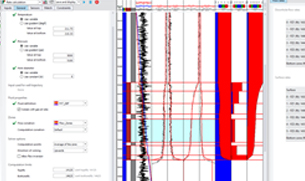
Pure shale points are graphically picked for the sand point, shale point, Obtained after the hydrocarbon correction. On the resulting plot, theīlack points represent the original points and the red points are the points Correction to account for hydrocarbonĮffects determines the porosity for the system. Pure shale, and the fluid must be defined. mud filtrate and hydrocarbons in the invaded zone.įor the sand, shale, and fluid system, the properties of clean sand,.wet shale, sand, formation water, and hydrocarbons in the uninvaded zone.These formationĬomponents are referred to in terms of fractional volumes. Minerals, rocks, and fluids present in the formation. The first step for using Techlog Thin Bed Analysis is to identify the Is corrected for, and inversion curves are output. Including saturation, for the formation components. Techlog Thin Bed Analysis is based on Thomas-Stieber modeling toĭetermine end points for correctly defining the response parameter values, Most effective approach to meet these challenges.

Thin Beds Analysis and the Python application workflow interface (AWI), was the
#Schlumberger techlog software
Solution, based on the Techlog wellbore software platform and using Techlog Schlumberger experts met with GUPCO to determine that a customized Identifying and evaluating thin beds using the Techlog platform

The unconventional reservoirs and thin beds in these fields. This required updating the company’s existing workflows for Gulf of Suez, GUPCO wanted to optimize its identification of intervals for Its portfolio includes eight operatingĬoncessions in the Gulf of Suez, with daily production of more than 78,000 bblĪs part of its work on reservoirs such as Asal, Kareem, and Nubia in the The Gulf of Suez Petroleum Company (GUPCO) is a joint venture between BPĪnd the Egyptian General Petroleum Corporation (EGPC) that focuses on oil and Updating characterization workflows for thin beds


 0 kommentar(er)
0 kommentar(er)
